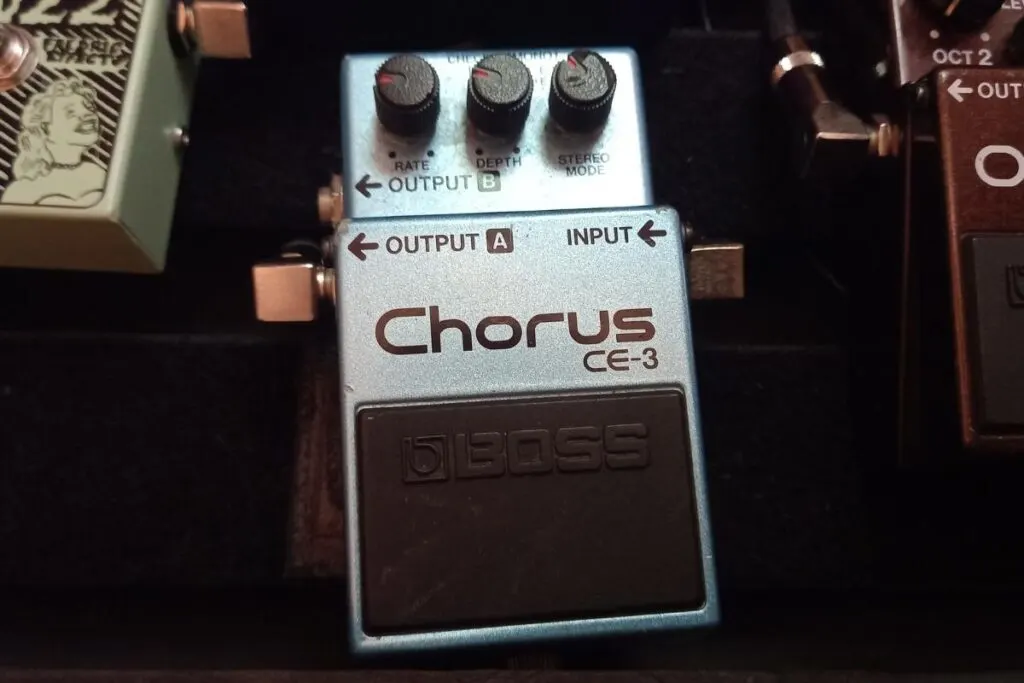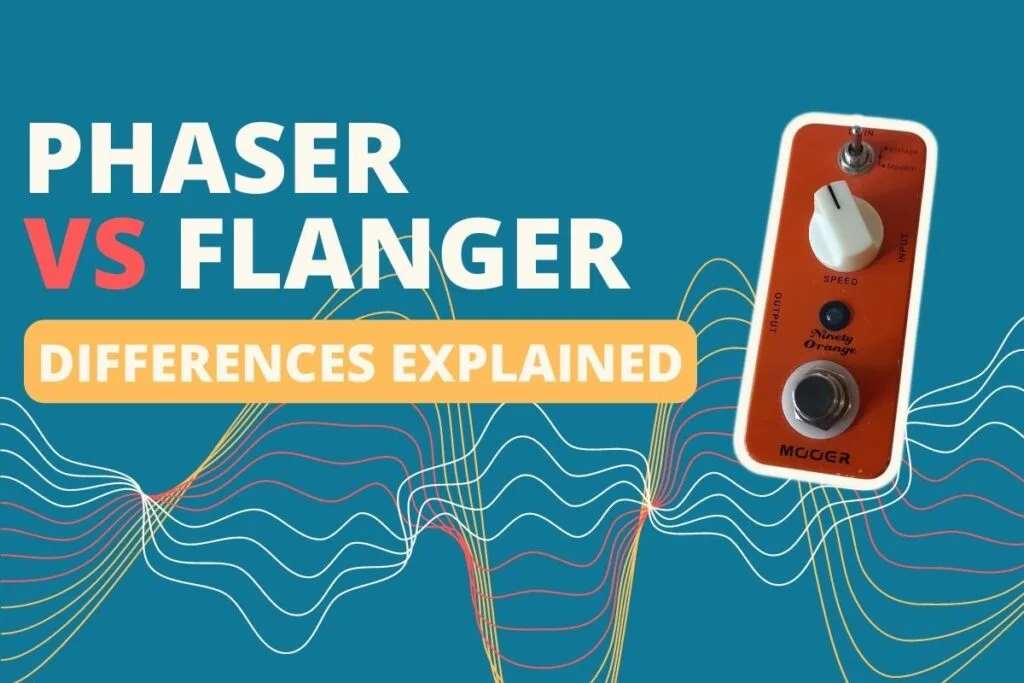Phaser and flanger are both often confused with each other, and it’s easy to see why. These two effects can create very similar sounds, but achieve them in different ways. Phasers and flangers have been used by some of the greatest bands in history, like Led Zeppelin, Rush, Pink Floyd… pretty much any rock band in the 70s and 80s!
Those with untrained ears probably wouldn’t hear the difference between a phaser and a flanger. Their effects are so similar that there’s very little difference on the surface. But that slight difference can add a completely unique touch to your music. So, what are the differences between the two? Let’s compare them on technical and practical levels.
What is a flanger?
A flanger effect is achieved by playing two identical audio signals together, with one slower than the other. The time gap between them is gradually increased and decreased using a low-frequency oscillator (LFO) which creates a “sweeping” sound. This sound is caused by the waveforms of both audio signals interacting with each other which builds or cancels certain frequencies at different times.
The flanger effect dates back to the 1950s when it was first used by Les Paul (yes, the Les Paul) in a 1952 recording. However, its discovery is widely accredited to The Beatles producer George Martin and band member John Lennon in the 1960s recording of the album “Revolver”.
There are disputes as to where the name term “flanger” actually came from, some historians credit John Lennon with coining the term himself. Others say that the term got its name from audio engineers playing two identical tapes and pressing down on the “flange” of one of the tapes to wobble it in and out of time.
Either way, it’s an effect that musicians have come to know and love over time, and was especially prominent in 1970s progressive rock. Nowadays, flanging is achieved through digital processes like effects pedals, amp settings, or plugins.
What does a flanger sound like?
The flanging effect creates a distinct “whooshing” that sounds a bit like a jet engine taking off. I’ve recorded an audio example for you here:
When used sparingly, flanging effects have a more natural sound than phasers. But, this can quickly change, if you crank up the settings too much. Flangers can quickly sound unruly and wash out whatever you’re playing if set too high.
Some examples of a flanger used in songs include “Unchained” by Van Halen, “Listen to the Music” by The Doobie Brothers, and “Barracuda” by Heart.
How to use a flanger
Most flangers have three main controls that you can change:
Depth: The depth is the amount of effect applied to the dry signal. You can think of this as how “strong” the flanger effect will be. A lower setting will have less flanging than a higher setting.
Rate: The rate is the speed of the flanging effect, generally between 0.1ms and 20ms. A lower setting will make a long, drawn-out effect. A higher setting will sound a lot more spacey.
Feedback: The feedback is the amount of the output signal that’s input back into the pedal, so it’s processed again. This can create some crazy effects, as you’re essentially layering the sound over and over.
These settings can be fun to play around and experiment with, and it’s what you should do in order to get the sound you want. My advice would be to tone it down when it comes to recording and playing live, as it can quickly wash out the sound of your guitar and other band members!
What is a phaser?
No, these phasers don’t have anything to do with Star Trek, but this effect will give your guitar an otherworldly tone. A guitar phaser pedal is another modulation effect pedal that gives a sense of atmosphere to your tone. Unlike flangers, however, the effects from phasers aren’t time based.
A phaser works by taking the original input signal and splitting it in two. One half of the signal is then “phase-shifted”, meaning that it’s pushed “out-of-time” with the other signal. The out of phase signal is then shifted back and forth using an LFO to create the “swirly” effect that is phasing.

What does a phaser sound like?
For all intents and purposes, a phaser sounds very similar to a flanger. In fact, a lot of people have a hard time distinguishing between the two. I find that a phaser generally sounds a lot crisper than a flanger, but subtler. Here’s an audio recording I made of a phaser effect on my guitar.
A phaser is often a lot more manageable than a flanger. Flangers can quickly get out of control with just a few slight adjustments. Phasers, on the other hand, are far more subtle and easier to manage. Your sound won’t become too overwhelming as quickly as with flangers, and there’s very little chance of feedback because of the way the flanger handles the signal.
Some examples of guitars using phaser pedals include the riff of Van Halen’s “Ain’t Talkin’ ‘Bout Love,” the opening sequence of Billy Joel’s “Just The Way You Are,” and the drums (not guitars) in Led Zeppelin’s “Kashmir.”
How to use a phaser
Most guitar phaser pedals have similar settings to flanger pedals:
Speed: Like a flanger’s “rate”, speed controls how quickly the effect happens. A lower setting will create a dreamy swirl as heard on the guitars in “Mayonnaise” by Smashing Pumpkins. A faster setting will create a rippling wave effect, as can be heard in “Breath (In The Air)” by Pink Floyd. Phaser pedals like the iconic MXR Phase 90 only have a speed knob.
Depth: This is the amount of the effect that’s applied to your guitar signal. A lower setting means less phase, and a higher setting means more!
Feedback: Not all phase pedals have a feedback setting, but for those that do, it’s a great way to get some whackier sounds out of the pedal. The feedback sends the output signal back into the input of the pedal. A lower setting means a weaker signal is passed back in, and a higher setting means a stronger signal. Feedback can quickly become unruly, so be careful with how much you use!
Phaser vs flanger vs chorus
Both phasers and flangers are known as modulation effect pedals. Modulation includes various effects, including tremolo and chorus. The confusing thing about modulation effects is that they often have plenty of overlap. Even though the technical side may be completely different, the effects can sound very similar except for some subtle differences.
One modulation effect that is sometimes confused with a flanger is the chorus effect. That’s because specific rate settings can make a flanger sound almost identical to a chorus pedal. And yet, they are very different.
All three pedals are similar in the first few steps. They all take the input signal and split them up into two signals. One of these signals is allowed to pass through unchanged, while the second signal is modulated in some way. The two (now wholly different) signals are then combined back into one signal at the end.
The point where the pedals differ is in what they do to the second signal. As we’ve already seen, phasers apply a phase-shifting effect. Flangers apply a time delay to the second signal.

Chorus pedals apply a tone shift to the second signal. For example, if you connect your guitar with your amp and play a chord, then immediately start turning one of your Tone knobs up and down, your tone will go up and down with it, back and forth between treble and bass, treble and bass. That’s precisely what a chorus pedal does to the second signal.
This modified signal is mixed in with the original signal again, creating a flanger-like, wavy sound.
Flangers and phasers have been popular since the 1970s, in the golden era of Led Zeppelin and Pink Floyd. The 1980s, on the other hand, are known for their shimmering chorus effects.
Other types of modulation pedals
All modulation pedals work on the basis of making some part of the sound grow louder and softer (or, at least, appear as if it is). Here are some other types of modulation effects pedals:
- Tremolo: Tremolo pedals simply move the volume up and down, similar to rapidly turning the volume knob on a radio up and down. It’s very often confused with vibrato.
- Vibrato: A vibrato pedal does the same thing as a chorus pedal by applying modulation to the signal’s tone. The only difference is that vibrato pedals don’t add the clean signal to the modulated signal; they send only the modulated signal to the output. Vibrato gives a result similar to that of the whammy bar or string bending.
- Rotary: A rotary pedal gives the illusion of sounds coming from different directions, similar to when an emergency vehicle with a siren drives past. These are based on the old Leslie rotary speakers. There is a level of louder-and-softer sound, with an additional layer of perceived direction and distance.
Summary of phasers vs flangers
Understanding the differences from a technical perspective helps, but sometimes it helps to compare the two modulation effects pedals side-by-side.
The key difference between the two is that a phaser splits the signal into two and phase shifts one of the split signals. A flanger duplicates the signal and moves one out of time with the other. It’s a very subtle difference that has a large effect on the overall sound.
Phasers and flangers are only two of the many different modulation effect pedals for guitars, but they are the most well-established in rock music history. They can sound very similar, making a choice between them a bit difficult for some. But now that you understand their similarities and differences, you will be able to make an informed decision when you purchase your next pedal.


Conor is a music producer, multi-instrumentalist, and all-round enthusiast from the UK with over 15 years of experience. He’s the founder and sole-content creator for the roundtable audio blog and YouTube channel.
